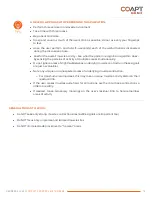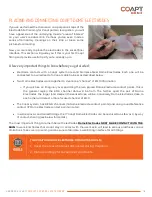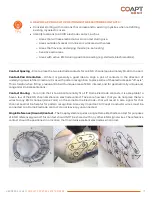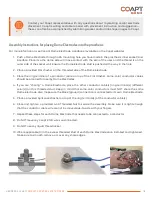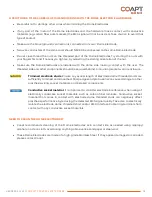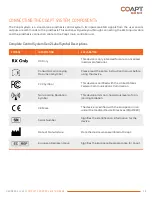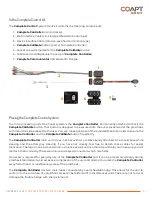
HANDBOOK (V
4.0)
COMPLETE CONTROL SYSTEM GEN2
6
considers the signal level from one electrode to control each prosthesis movement. In other words, standard
myoelectric control is like listening to music and only knowing how loud the sound is, while pattern recognition
is like hearing what song is playing.
Key benefits of pattern recognition over standard myoelectric control include the following:
•
Intuitive Control
– Natural movement intents are used to control the prosthesis, generally making it
easier to use. For example, the feeling of opening or closing a hand is used to control the prosthetic hand
open and close (instead of wrist flexion motions to control the hand common for basic myoelectric
devices).
•
No Mode-Switching
– There is no need to use cumbersome actions like co-contractions, pulses, fast-
slow gestures, etc. and this makes the control of a prosthesis more seamless.
•
Strong muscle contractions are not required
– Pattern recognition has the advantage of being able to
utilize low intensity muscle contractions as needed. This is beneficial for standard myoelectric control
users who were required to elicit strong control contractions that tire them out quickly.
•
Superior Proportional Control
– A wider range of control speeds are available because myoelectric
inputs do not need to be limited by thresholds and a broader range of input levels can be recognized by
the algorithms.
•
Flexible Electrode Placement
– There is much less need for isolated signals or precise electrode
placements. This opens the door to more functional myotesting, freedom to place electrodes for socket,
comfort, or limb constraints and provides helpful forgiveness in prosthesis donning.
•
Calibration and Setup
– Control can be refined and personalized at any time using the quick on-board
calibration. This makes addressing changes in socket fit, skin condition, fatigue, desired feelings for
control, and much easier to take on without the need to take the prosthesis off or make extra clinic visits.
What Is Key to Making Pattern Recognition Function at Its Best?
Repeatability
:
Pattern recognition works best if the user can replicate the patterns of muscle signals for each
motion the same way each time. Each motion should “feel” the same each time the user performs it.
Differentiation
:
Pattern recognition requires the pattern of muscle signals to be different for each distinct
motion. Each motion should “feel” different from all other motions.
Practicing Pattern Recognition Control
•
No need for extra-hard muscle contractions. Contraction levels should be moderate – like the feeling in
the strength of a comfortable handshake.
•
Start slow and practice patience. This new pattern recognition method of control can take a little time
and practice to get used to.

















